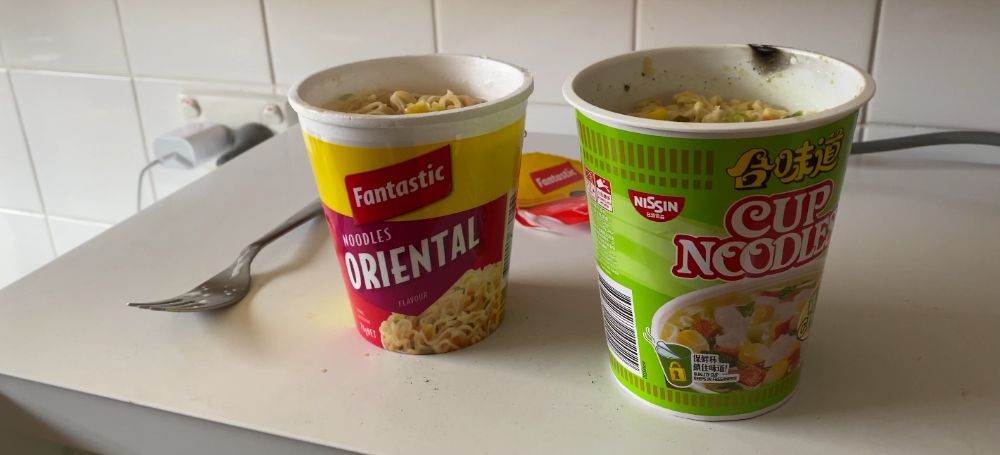The containers are usually made from styrofoam and can release chemicals into the ramen if heated in a microwave. It’s also not advised to microwave instant noodle cups because the noodles can get so hot that the cup can deteriorate and leak.
Given that it requires almost no effort to prepare, it is one of the most satisfying and convenient foods available. Unsurprisingly, it has established itself as a standard in most college residence halls and apartments around the world.
Of course, despite how handy it already is, one of the most frequently asked queries is whether or not one can prepare noodles in the microwave.
Therefore, since the label clearly states that these containers are not microwave-safe, you should not microwave Cup Noodles. Instead, you can boil water, pour it into the cup until it reaches the indicated fill line, cover the noodles, and let them cook for 3 minutes.
Having said that, we’ll go into more detail about this subject as we discuss why you shouldn’t microwave your Cup Noodles.
Having said that, we’ll give you some pointers on how to make this delectable snack and a list of our personal favorites that you must try. So, be sure to keep reading.
Can Microwaving Cup Noodles Causes Cancer? The Health Risks of Noodle Cups

If you use styrofoam or plastic noodle cups and put hot water in them, you may not kill yourself by setting your house on fire, but you are likely increasing your risk of developing cancer.
Styrofoam cup noodles should not be microwaved or placed in hot water. They have been shown to cause the probable carcinogen styrene to seep into your food, greatly raising your risk of developing cancer.
This scientific study demonstrated that the leaching of styrene from styrofoam cups and water bottles into water occurred, and that temperature played a significant role in the amount of leaching of dangerous chemicals that took place.
The higher the temperature the more leeching occurred!
| Temperature (ºC) | Styrene (µg/L) |
| Ambient | 0.00 |
| 50 | 0.00 |
| 70 | 1.16 |
| 90 | 9.35 |
| 100 | 17.37 |
This report concluded that:
Because of styrene’s toxicity and tendency to leach into water and other materials, polystyrene (PS) material shouldn’t be used for food packaging. Foam and rigid PS cups should not be used for hot beverages in particular. Paper cups pose no threat compared to PS cups and are safe for hot beverages. Additionally, it is advised that a public awareness campaign be started to discourage the use of Styrofoam cups for hot beverages.
Noodle cups are made to be used with boiling water that is 90 to 100 degrees Celsius or higher, so they are very likely to leach chemicals into your noodles.
The plastic noodle cup isnt much better either. According to scientists at Goethe University they found that estrogenic compounds can leach from this type of plastic into the water. Learn more here.
On the other hand, paper cups appear to be fine, but cardboard can leech these substances.
Does microwaving cup noodles cause cancer?
Yes, microwaving cup noodles can potentially cause cancer. The bowl of cup noodles contains toxic chemicals like styrene, which when heated in a microwave can leach into the food.
Carcinogens that raise the risk of cancer are known to be present in styrene chemicals. Styrofoam may not even be safe to microwave for 30 seconds, depending on the microwave’s cooking time and power level.
The risk of cancer can be increased by the microwave heating of cup noodles because carcinogenic chemicals may leach into the noodles and hot bone broth.
A significant factor in the leaching of cancer-causing chemicals into food is the use of boiling water and high microwave temperatures to cook the noodles. However, when microwaved, styrofoam coffee cups also release toxic chemicals into the food.
The cups will release cancer-causing chemicals into the food and increase the likelihood of health problems because the insulated foam material is not intended for high temperatures.
What About “Microwave Safe” Cup Noodles?

Many manufacturers of instant ramen noodles and cup noodles have experimented with creating a cup noodle that is “microwave safe” in recent years. ” Nissin cup noodles are one example of this. I personally haven’t tried heating up these particular cup noodles in the microwave, so I can’t vouch for it. Just make sure to carefully read the instructions if you want to give it a try.
My advice is to use microwave-safe cups rather than microwaving the cup noodles directly in the plastic cup if you still plan to microwave them. It’s easy to do but a lot safer.
Simply place your cup noodles inside a microwave-safe container with a cup of water. Put the lid on the container after microwaving on medium for 1 minute and repeating every 30 seconds. Take the container out of the microwave after 2 minutes or when the noodles are soft and steaming hot, give them a good stir, and the noodles are then ready to eat.
FAQ
Why does it say do not microwave cup of noodles?
When microwaved, harmful chemicals from cup noodles containers seep into the noodles. Plastic and Styrofoam cups are made of materials that could melt when exposed to high temperatures. The containers are not made to withstand the microwave’s superheated water used to cook the noodles.
What happens if you put cup noodles in the microwave without water?
Uncooked noodles catch fire in the microwave because the microwave beams hit them hard and dry them out if you microwave them without water. The noodles catch fire when the temperature is too high without any water.
